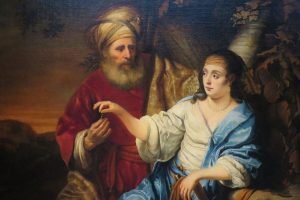Life is full of trouble. That should be obvious. And, when trouble comes, oftentimes Catholics and other Christians don’t know how to reconcile their grief and affliction with their faith in God. We tell each other things like “God has a plan” or “God won’t give you more than you can handle.” But these rarely offer consolation. And in the absence of true comfort and tangible solidarity, something else enters into the troubled situation: half-truths and lies about ourselves, others, and God.
My own life has been characterized by several versions of this. One came about when I was fourteen years old. I suffered a severe concussion and many subsequent smaller ones that led to seizures. Although I was a football player—a defensive end and offensive guard—football was not the original culprit. No, the culprit was a teenage party with a trampoline. At the party, I got on the trampoline with teen acquaintances who were not sober. I lost my balance, fell, and for a few minutes there were people accidentally jumping on my head. I eventually was pulled off and was bleeding out of one of my ears. Not wanting to get in trouble for being at the party, I did not tell my parents at that time. So, I cleaned myself up, went home, and kept it to myself and my friends for as long as I could. I stubbornly continued to play football for the rest of the season. Not surprisingly, that was not a wise decision.
Soon thereafter, I began to have seizures. Whether in class, at mass, at football or band practice, at a friend’s house, or in bed at night, I first would feel nausea and dread and then strange and disoriented. Suddenly, it was like an invisible electrical hand would seize my head, lock my brain in a painful vice, accelerate my thoughts and overstimulate my perception into a tornado of activity, and I thought I would see eternity opened up in flashes of lightning. I rarely ever had outward symptoms that others would notice because I learned to “flow” with the current in public. The seizures would last for a short amount of time, I would wait with as little movement as possible until the invisible hand would release my brain, the skies would close, and the dread and nausea subside. Then, I would reorient to reality, tell no one, and continue my day as if nothing happened. This became my ingrained habit for many years.
I thought the seizures were “visions” from God. After all, my family was part of a charismatic Catholic parish and adults were known to have visions and vivid dreams in which God or Mary would visit them and speak. I also was steeped in unresolved childhood trauma and thought God was inflicting pain on me because I was a bad person who had done horrible things. Paradoxically, I was tormented by feeling god-forsaken and god-punished. I had a distorted vision of myself, God, and others. Ironically, I also thought that these seizure-visions made me special. I hated them, they were painful, and they grabbed me at random times. But I made myself think there was a divine reason for them. Someday, it all would make sense in God’s own time. God must be testing me because God wouldn’t give me anything I couldn’t handle, right? If I was just good enough, smart enough, acceptable enough, God would make everything better.
But it did not get better. In fact, I continued to have these seizures for the next fourteen years. Since I was stamped with fear towards God’s unpredictable and charismatic presence, however, it never occurred to me that they were seizures. Like many characters in the Gospels, I was injured and ill but did not understand what ailed me. I was afflicted with a confluence of physical, psychological, emotional, and spiritual ailments. And I felt that the normal structures of society, family, and faith had failed me. So, to hell with them all.
As theologian Robert J. Schreiter wisely pointed out in his first book entitled Reconciliation, “We need, then, to find an orthopathema, a right way to suffer, when our orthodoxies (right beliefs) have been shattered and our orthopraxies (right practices) have come to naught.” He continues, “A right way of suffering, then, involves regaining our humanity.”
This is one thing that Mark’s gospel illustrates: how a right way of suffering can lead to regaining our humanity. In Mark 5, the gospel writer describes people in predicaments of dire affliction who, through encountering Jesus, are empowered to regain their humanity. In each case, a wound has been inflicted, and a person feels isolated in their grief and affliction and into this ruptured tissue an infection of lies and deceit begins to take hold of god-forsakenness and divine punishment. The demoniac cries out, “What do you want with me, Jesus, Son of the Most High God? In God’s name, don’t torture me!” (Mk 5:7). The woman bleeding for more than a decade with no cure and marginalized by some in her community because of it, fears the consequences of physically touching this holy man, “knowing what had happened to her, came and fell at his feet and, trembling with fear, told him the whole truth” (Mk 5:33). And the family of Jairus, a pious and faithful Pharisee, scoffs at Jesus’ claim that God’s promise abides for the parents who have lost their beloved daughter (Mk 5:35-40)
The possessed man, the bleeding woman, and the grief-stricken parents are experiencing little consolation from their faith communities and may be questioning their own graced humanity. God has not kept God’s promise. God has abandoned them to an endless cycle of grief, affliction, and pain.
In all three of these situations, Jesus enters, intuits, and responds with compassion to undo the knots created by these deceptions for the empowerment and salvation of those who are afflicted. Through Jesus, each grasps their own God-given dignity once again and receives an invitation to be restored into an awareness of a positive relationship with God and to seek reconciliation with their communities that had wounded them.
This does not mean that Jesus made everything perfect. Life does not work that way, even in the Gospels. The healed man still has to reckon with his original trauma and the harm it made him inflict on himself and others. The healed woman carries the painful memory of years of suffering, squandering all of her money on false cures, and being marginalized by many in her own community because of her ailment. Jairus’ daughter will carry this bizarre experience with her until she dies again and her parents will carry the memory of her untimely death and their own ensuing crisis of meaning.
Nevertheless, Jesus’ healing ministry really did something. It disrupted the downward spiral of resignation to ceaseless affliction and the hopelessness it breeds. He offered a way for each to move forward in dealing with their suffering: an orthopathema. Each has been set free from a particular trouble and has regained their humanity. All will continue to navigate their way along life’s path in which more trouble is all but guaranteed. But Jesus’ physical presence reminds each that God is with them in the pain and offers a way through the suffering.
Healing (if it arrives) and a way forward (when it arrives and is recognized) can be unexpected.
For me, as the seizures continued into my young adulthood, I began mental health counseling for emotional and psychological problems. My diagnosis, bipolar disorder, turned out to be inaccurate (years later I was accurately diagnosed with depression, dissociations, and PTSD that I am still learning to manage). But, there was an upshot to the misdiagnosis. One of the medications prescribed to me to treat bipolar disorder happened to fall into a class that was used primarily as an anti-convulsant and anti-epileptic. I began taking it for bipolar disorder and in a relatively short amount of time, my seizures dissipated. No more invisible electric hand, no more visions, no more dread and nausea. This serendipitous occurrence probably helped save my life, or at least provided a much better quality of life with a chance to heal. And, through healthy relationships and a supportive church community, I found a way forward.
Trouble pervades our lives. Suffering cannot be avoided no matter how wealthy we are, how religious we are, how “good” we are. These Jesus-memories from Mark 5 testify that when trouble finds us, God is still with us. This memory waits for us in times of need, forgetfulness, and obliviousness. God does not abandon us, no matter what, and a Christian community at its best can offer something more important than just right belief (orthodoxy) and right practice (orthopraxis). It can offer a right way to suffer (orthopathema); a lifegiving way to survive affliction, trouble, and grief without being annihilated; ways to transform pain into something that can give life as opposed to taking life; ways to resist dehumanization and oppression by others; and ways to repair our relationships that were broken during these times of affliction.
The stories of Jesus the healer in Mark 5 hold this memory when we forget. Because trouble will find us. That much is guaranteed. May our faith communities learn to carefully hold and pass on these Jesus-memories when we are in need of a path through the affliction, suffering, and grief and toward the possibility of a renewed future.
Image: Unsplash/Road Trip with Raj












Add comment